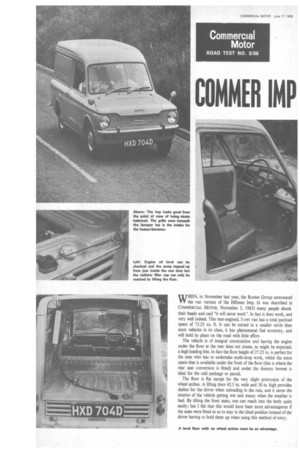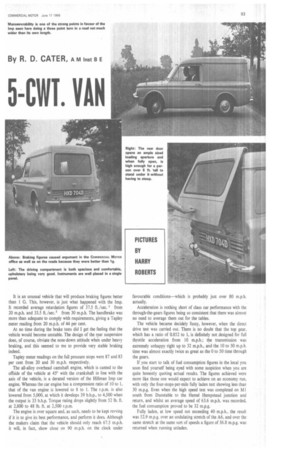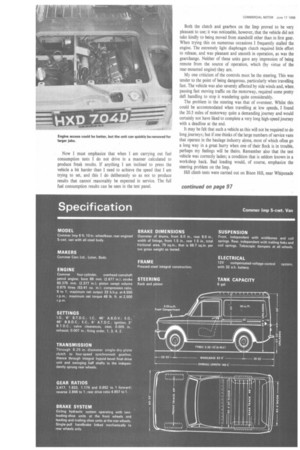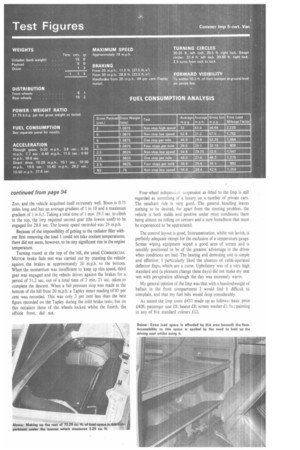COMER IMP
Page 94

Page 95

Page 96

Page 99

If you've noticed an error in this article please click here to report it so we can fix it.
5-CWT. VAN
WHEN, in November last year, the Rootes Group announced the van version of the Hillman Imp, (it was described in COMMERCIAL MOTOR, November 5, 1965) many people shook their heads and said "it will never work". In fact it does work, and very well indeed. This rear-engined, 5-cwt van has a total payload space of 73.25 Cu. ft. It can be turned in a smaller circle than most vehicles in its class, it has phenomenal fuel economy, and will hold its place on th road with little effort.
The vehicle is of integral construction and having the engine under the floor at the rear does not create, as might be expected, a high loading line. In fact the floor height of 27.25 in. is perfect for the man who has to undertake multi-drop work, whilst the extra space that is available under the front of the floor (this is where the rear seat conversion is fitted) and under the dummy bonnet is ideal for the odd package or parcel.
The floor is flat except for the very slight protrusion of the wheel arches. A lifting door 42.5 in. wide and 30 in. high provides shelter for the driver when unloading in the rain, and it saves the interior of the vehicle getting wet and messy when the weather is bad. By tilting the front seats, one can reach into the body quite easily; but I felt that this would have been more advantageous if the seats were fitted so as to stay in the tilted position instead of the driver having to hold them up when using this method of entry. It is an unusual vehicle that will produce braking figures better than 1 G. This, however, is just what happened with the Imp. It recorded average retardation figures of 37.5 ft. /sec. 2 from 20 m.p.h. and 33.5 ft. /sec.' from 30 m.p.h. The handbrake was more than adequate to comply with requirements, giving a Tapley meter reading from 20 m.p.h. of 44 per cent.
At no time during the brake tests did I get the feeling that the vehicle would become unstable. The design of the rear suspension does, of course, obviate the nose-down attitude when under heavy braking, and this seemed to me to provide very stable braking indeed.
Tapley meter readings on the full pressure stops were 87 and 83 per cent from 20 and 30 m.p.h. respectively.
The all-alloy overhead camshaft engine, which is canted to the offside of the vehicle at 450 with the crankshaft in line with the axis of the vehicle, is a derated version of the Hillman Imp car engine. Whereas the car engine has a compression ratio of 10 to 1, that of the van engine is lowered to 8 to 1. The r.p.m. is also lowered from 5,000, at which it develops 39 b.h.p., to 4,500 when the output is 33 b.h.p. Torque rating drops slightly from 52 lb. ft. at 2.800 to 48 lb. ft. at 2,500 r.p.m.
The engine is over square and, as such, needs to be kept revving if it is to give its best performance, and perform it does. Although the makers claim that the vehicle should only reach 67.5 m.p.h. it will, in fact, show close on 90 m.p.h. on the clock under
favourable conditions—which is probably just over 80 m.p.h. actually.
Acceleration is nothing short of class car performance with the through-the-gears figures being so consistent that there was almost no need to average them out for the tables.
The vehicle became decidely fussy, however, when the direct drive test was carried out. There is no doubt that the top gear, which has a ratio of 0.852 to 1, is definitely not,designed for full throttle acceleration from 10 m.p.h.; the transmission was extremely unhappy right up to 32 m.p.h., and the 10 to 50 m.p.h. time was almost exactly twice as great as the 0 to 50 time through the gears.
If you start to talk of fuel consumption figures in the local you soon find yourself being eyed with some suspicion when you are quite honestly quoting actual results. The figures achieved were more like those one would expect to achieve on an economy run, with only the four-stops-per-mile fully laden test showing less than 30 m.p.g. Even when the high speed test was completed on M1 south from Dunstable to the Hemel Hempstead junction and return, and whilst an average speed of 63.6 m.p.h. was recorded. the fuel consumption proved to be 32 m.p.g.
Fully laden, at low speed not exceeding 40 m.p.h.. the result was 52.9 m.p.g. over an undulating stretch of the A6, and over the same stretch at the same sort of speeds a figure of 56.8 m.p.g was returned when running unladen. Now I must emphasize that when I am carrying out fuel consumption tests I do not drive in a manner calculated to produce freak results. If anything I am inclined to press the vehicle a bit harder than I need to achieve the speed that I am trying to set, and this I do deliberately so as not to produce results that cannot reasonably be expected in service. The full fuel consumption results can be seen in the test panel. Both the clutch and gearbox on the Imp proved to be very pleasant to use; it was noticeable, however, that the vehicle did not take kindly to being moved from standstill other than in first gear. When trying this on numerous occasions I frequently stalled the engine. The extremely light diaphragm clutch required little effort to release, and was pleasant and smooth in operation, as was the gearchange. Neither of these units gave any impression of being remote from the source of operation, which (by virtue of the rear-mounted engine) they are.
My one criticism of the controls must be the steering. This was tender to the point of being dangerous, particularly when travelling fast. The vehicle was also severely affected by side winds and, when. passing fast moving traffic on the motorway, required some pretty deft handling to stop it wandering quite considerably.
The problem in the steering was that of oversteer. Whilst this could be accommodated when travelling at low speeds, I found the 20.5 miles of motorway quite a demanding journey and would certainly not have liked to complete a very long high-speed journey with a deadline at the end.
It may be felt that such a vehicle as this will not be required to do long journeys; but if one thinks of the large numbers of service vans that operate in the haulage industry alone, most of which often go a long way in a great hurry when one of their flock is in trouble, perhaps my feelings will be theirs. Remember also that the test vehicle was correctly laden; a condition that is seldom known in a workshop hack. Bad loading would, of course, emphasize the steering problem on the Imp.
Hill climb tests were carried out on Bison Hill, near Whipsnade Zoo, and the vehicle acquitted itself extremely well. Bison is 0.75 miles long and has an average gradient of 1 in 10 and a maximum gradient of I in 6.5. Taking a total time of 1 min. 39.3 sec. to climb to the top, the Imp required second gear (the lowest used) to be engaged for 28.8 sec. The lowest speed recorded was 29 m.p.h.
Because of the impossibility of getting to the radiator filler without first removing the load I could not take coolant temperatures; there did not seem, however, to be any significant rise in the engine temperature.
Turning round at the top of the hill, the usual COMMERCIAL MOTOR brake fade test was carried out by coasting the vehicle against the brakes at approximately 20 m.p.h. to the bottom. When the momentum was insufficient to keep up this speed, third gear was engaged and the vehicle driven against the brakes for a period of 51.2 sec. out of a total time of 2 min. 21 sec. taken to complete the descent. When a full pressure stop was made at the bottom of the hill from 20 m.p.h. a Tapley meter reading of 85 per cent was recorded. This was only 3 per cent less than the best figure recorded on the Tapley during the cold brake tests; but on this occasion three of the wheels locked whilst the fourth, the offside front, did not.
Four-wheel independo.nt suspension as fitted to the Imp is still regarded as something of a luxury on a number of private cars. The resultant ride is very good. The general handling leaves nothing to be desired, for apart from the steering problem, the vehicle is both stable and positive under most conditions there being almost no rolling on corners and a sure footedness that must be experienced to be appreciated.
The control layout is good. Instrumentation, whilst not lavish, is perfectly adequate except for the exclusion of a temperature gauge. Screen wiping equipment wiped a good area of screen and is sensibly positioned to be of the greatest advantage to the driver when conditions are bad. The heating and demisting unit is simple and effective; I particularly liked the absence of cable-operated deflector flaps, which are a curse. Upholstery was of a very high standard and (a pleasant change these days) did not make my seat wet with perspiration although the day was extremely warm.
My general opinion of the Imp was that with a hundredweight of ballast in the front compartment I would find it difficult to complain, and that my fuel bills would drop considerably.
As tested the Imp costs £437 made up as follows: basic price £408; passenger seat £8; heater £8; screen washer £1 5s.; painting in any of five standard colours £12.




















































































































































